Monthly Archives: December 2018

 Two days ago, I wrote a story in celebration of my Uncle George Wave Hushman’s 92nd birthday. Little did I now that it would also be the day of his home-going, but it was. It is a rather rare thing, except in infant deaths, for someone to be born and die on the same day, but that is what my Uncle George did. He was born on December 20, 1926 in Rock River, Wyoming, and went home to Heaven on December 20, 2018 in Mills, Wyoming…exactly 92 years later.
Two days ago, I wrote a story in celebration of my Uncle George Wave Hushman’s 92nd birthday. Little did I now that it would also be the day of his home-going, but it was. It is a rather rare thing, except in infant deaths, for someone to be born and die on the same day, but that is what my Uncle George did. He was born on December 20, 1926 in Rock River, Wyoming, and went home to Heaven on December 20, 2018 in Mills, Wyoming…exactly 92 years later.
Uncle George led an unusual life, so I guess I shouldn’t be surprised that his home-going would be just as unusual. He lost his mother when he was just eleven years old. I’m not sure how long after her passing, before he was sent to the Wyoming State Children’s Home in Casper, Wyoming, but during those years, his guardian was listed as Ethel S. Kittle. Uncle George didn’t know much about his family for most of his life, but his dad, also named George Wave Hushman was in the Navy, stationed in the Philippines when he was killed in action on November 21, 1943…Uncle George was just 17 years old. To his knowledge, that left him very much alone in this world, except for his friend James Wesley Saint John ‘Wes” and Wes’ family, who had unofficially adopted him as a part of their family. Wes, who was three years older than Uncle George was lost at sea on September 9, 1943. While Uncle George didn’t know his father well, he did know his friend, and I find it unusual that he enlisted in the Navy too, but he did. His Draft Card listed his next of kin as WE Saint John. He mustered out on May 31, 1944, and was later listed among the wounded. I am grateful that he was one of those who made it home from the war. Uncle George, was first assigned to LCI(L) 23…Landing Craft Infantry (L)23. He later mustered out on USS Gurke (DD-783), a Gearing-class destroyer.
By 1946, Uncle George was released from the Navy, and was living in Mills, Wyoming, and falling in love with my aunt, Evelyn Byer, whom he married on September 1, 1947. He had found the love of his life, and he only wanted to be with her for the rest of his life…missing her terribly after she passed away on May 4, 2015. Aunt 
 Evelyn and Uncle George would be blessed with five children, George Hushman, Susie Young, Shelly Campbell, Shannon Limmer, and Greg Hushman. They were also blessed with many grandchildren, great grand children, and great great grandchildren. Uncle George was also blessed to be able to reunite with his half siblings over the years, although their passings brought him a feeling of losing them twice. Now that they are together again in Heaven, Uncle George will never have to be away from his beloved Evelyn, or the other loved ones who had gone before him. Rest in peace Uncle George. We love and miss you very much.
Evelyn and Uncle George would be blessed with five children, George Hushman, Susie Young, Shelly Campbell, Shannon Limmer, and Greg Hushman. They were also blessed with many grandchildren, great grand children, and great great grandchildren. Uncle George was also blessed to be able to reunite with his half siblings over the years, although their passings brought him a feeling of losing them twice. Now that they are together again in Heaven, Uncle George will never have to be away from his beloved Evelyn, or the other loved ones who had gone before him. Rest in peace Uncle George. We love and miss you very much.
 My great grand niece, Izabella Siara Harman is quite a girl. She is the middle of her parents, Jake and Melanie Harman’s children, and quite the feisty one. Her grandmother, my niece, Chantel Balcerzak says she got her sassy attitude from her. Maybe that’s so, but Belle, as she is often called wears her sassiness well, and I think she is a total sweetie. If it’s possible, she wears her sassiness well.
My great grand niece, Izabella Siara Harman is quite a girl. She is the middle of her parents, Jake and Melanie Harman’s children, and quite the feisty one. Her grandmother, my niece, Chantel Balcerzak says she got her sassy attitude from her. Maybe that’s so, but Belle, as she is often called wears her sassiness well, and I think she is a total sweetie. If it’s possible, she wears her sassiness well.
Being just three years old, Belle is very curious about many things. She is still discovering the world around her, but she is beginning to be very aware of the things she likes and the things she doesn’t. She is developing her own personal style, and this girl is a girly girl. One of the things little Belle absolutely loves is lip balm…any version…tinted or just chapstick. I can’t blame her. I like the feel of lip balm too,so I can see why she would. Plus, I’m sure it makes her feel pretty.
Another thing that Belle has discovered and really has become pretty obsessed with is pockets. She wants pockets on her clothes, and she likes them on other people’s clothes. It could be because she knows that there are often cool things in those pockets, especially lip balm, or she likes being able to keep her own treasures in her pockets. Its funny what things kids decide that they really like. Well, this Belle’s things are lip balm and pockets.
 The other day, Belle wanted her dad’s chap stick, so he took it out of his pocket and gave it to her. Belle put some chap stick on, and after putting the lid back on, Belle promptly tucked it into the only pocket she had…or thought she had…her pull-up. She used it just like it was a pocket. After the moment of shock, her dad laughed and said, “Well that’s one chap stick I won’t be using again!!” Hahahahaha!! I don’t suppose he would either. What a goofy girl she is. I guess in the future, her parents are going to have to make sure that every outfit has a pocket, just in case she borrows a chap stick again.
The other day, Belle wanted her dad’s chap stick, so he took it out of his pocket and gave it to her. Belle put some chap stick on, and after putting the lid back on, Belle promptly tucked it into the only pocket she had…or thought she had…her pull-up. She used it just like it was a pocket. After the moment of shock, her dad laughed and said, “Well that’s one chap stick I won’t be using again!!” Hahahahaha!! I don’t suppose he would either. What a goofy girl she is. I guess in the future, her parents are going to have to make sure that every outfit has a pocket, just in case she borrows a chap stick again.
Well, little Belle will probably get over the lip balm and pocket stage at some point, but I seriously doubt if she will ever get over being the little cutie she is, because that is totally impossible. I love the excitement she shows every time I see her and her siblings. She always makes me smile. Today is Belle’s 3rd birthday. Happy birthday Belle!! Have a great day!! We love you!!

 My grand nephew, Isaac Spethman has always been an industrious young man. From the time he was just 7 years old, Isaac has had a job. I know that sounds odd, but I’m not talking about chores. Yes he had those too, but this was different. Isaac decided that he wanted a job, so he asked a local grocery store if he could have a job. They were amused, and told him to bring in a résumé. He went to his Aunt Liz Masterson, who is a teacher, because he thought she could help, and she created a résumé for him. When he took it in, I think the store was quite surprised, but they couldn’t resist, this industrious young man, so they gave him a job. Of course, with child labor laws, they could only have him work a few hours a week, and there were some jobs he could not do, but they let him sweep, and take out the trash, straighten, and other such jobs, and they paid him in goods, instead of money. They also framed his résumé and hung it on the wall. The little store has changed hands three times since Isaac went to work there, but Isaac continues to have a job with each new owner. They see that he is a quality worker, and that speaks so well for Isaac. He did different things for each owner, and they are very careful about what he can do because of laws, but they all love having him work for them.
My grand nephew, Isaac Spethman has always been an industrious young man. From the time he was just 7 years old, Isaac has had a job. I know that sounds odd, but I’m not talking about chores. Yes he had those too, but this was different. Isaac decided that he wanted a job, so he asked a local grocery store if he could have a job. They were amused, and told him to bring in a résumé. He went to his Aunt Liz Masterson, who is a teacher, because he thought she could help, and she created a résumé for him. When he took it in, I think the store was quite surprised, but they couldn’t resist, this industrious young man, so they gave him a job. Of course, with child labor laws, they could only have him work a few hours a week, and there were some jobs he could not do, but they let him sweep, and take out the trash, straighten, and other such jobs, and they paid him in goods, instead of money. They also framed his résumé and hung it on the wall. The little store has changed hands three times since Isaac went to work there, but Isaac continues to have a job with each new owner. They see that he is a quality worker, and that speaks so well for Isaac. He did different things for each owner, and they are very careful about what he can do because of laws, but they all love having him work for them.
In addition to his work in retail grocery, Isaac also frequently works with his Dad, Steve Spethman and for his Uncle Bruce Gothard on weekends doing various odd jobs. He worked for his Great Uncle Mike Reed out at his ranch picking up nails all over the property when they were tearing down some old sheep pens. There were nails everywhere! He was diligent and picked up many, many nails. The nails could either be reused, or were thrown away, so people didn’t step on them or run over them. Isaac also frequently asks his grandmothers, Cheryl Masterson and Marie Spethman if they have any odd jobs he can do. He’s sure a worker! He is willing to work hard for what he wants, and that has really gained him a lot of respect. Recently he has become one of 
 the ushers at church, and he takes that job very seriously, making sure that he does it properly.
the ushers at church, and he takes that job very seriously, making sure that he does it properly.
Isaac reminds many of us, in the family, of our dad and grandfather, Allen Spencer. Isaac even looks like him in some of the very young pictures we gave of him. Time will tell, if he will continue to resemble him as he grows up, but I wouldn’t be surprised, and I know my dad would really like that…especially his work ethic. Today is Isaac’s 12th birthday. Happy birthday Isaac! Have a great day!! We love you!!
 Most of the time, the oldest sibling is the first to marry, and true to that thought, my Aunt Evelyn Byer was the first of my Grandma and Grandpa Byer’s nine children to marry. The love of her life turned out to be George Hushman, a young man who was raised in the children’s home in Casper, Wyoming, after losing both of his parents at a very young age. His mother, Wyoma Woodfork Hushman passed away when George was just 11 years old, and his dad, George Wave Hushman was killed in action during World War II, when George was just 17 years old. Uncle George’s dad was unable to take care of him after his mother died, so at some point he ended up in the
Most of the time, the oldest sibling is the first to marry, and true to that thought, my Aunt Evelyn Byer was the first of my Grandma and Grandpa Byer’s nine children to marry. The love of her life turned out to be George Hushman, a young man who was raised in the children’s home in Casper, Wyoming, after losing both of his parents at a very young age. His mother, Wyoma Woodfork Hushman passed away when George was just 11 years old, and his dad, George Wave Hushman was killed in action during World War II, when George was just 17 years old. Uncle George’s dad was unable to take care of him after his mother died, so at some point he ended up in the  children’s home. I’m sure many people would think that his would always be a sad story, but it wasn’t. Uncle George had a friend James Wesley Saint John…who went by Wes. They were good friends, and Uncle George spent a lot of time at his parents house. Wes’ mom, Hettie Saint John became like an adopted mom to Uncle George. She was a very stabilizing influence in his life. As the years went on the two men grew up and went into the service. Unfortunately, only one of them would come back home. Wes was lost at sea in 1944, and they never found out what happened to him. It was a hard loss for Hettie, and for Uncle George.
children’s home. I’m sure many people would think that his would always be a sad story, but it wasn’t. Uncle George had a friend James Wesley Saint John…who went by Wes. They were good friends, and Uncle George spent a lot of time at his parents house. Wes’ mom, Hettie Saint John became like an adopted mom to Uncle George. She was a very stabilizing influence in his life. As the years went on the two men grew up and went into the service. Unfortunately, only one of them would come back home. Wes was lost at sea in 1944, and they never found out what happened to him. It was a hard loss for Hettie, and for Uncle George.
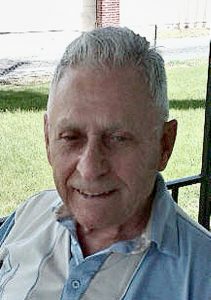
Uncle George went on to marry my Aunt Evelyn on September 1, 1947. While the sadness of losing his friend and not knowing any of his family lingered, Uncle George was a very happy family man. He and Aunt Evelyn would be blessed with five children, and they would be married for almost 68 years before Aunt Evelyn’s passing in 2015. Uncle George has been in frail health since Aunt Evelyn’s passing, but I know that their time together is still vivid in his mind, because she was the love of his life. I remember so many fun times they had with my parents. they bowled together, double dated, went to dances, and spent time at each others house. They were more that sisters and brothers-in-law, they were best friends. I really miss those good times they had, because w, their kids got to have those good times too. Today is Uncle George’s 92nd birthday. What an amazing milestone that is. Happy birthday Uncle George!! Have a great day!! We love you!!

 My niece, Michelle Stevens sees things that most of us would miss. Of course, when I say that, I am talking about seeing art in things most of us couldn’t even imagine. Not all of these things were her ideas, but she could make them work, because she is very talented. Her artwork is truly prize winning. Michelle has studied every form of art in her pursuit of her art education degree, and I think she could do any of them and will no doubt create some in the future.
My niece, Michelle Stevens sees things that most of us would miss. Of course, when I say that, I am talking about seeing art in things most of us couldn’t even imagine. Not all of these things were her ideas, but she could make them work, because she is very talented. Her artwork is truly prize winning. Michelle has studied every form of art in her pursuit of her art education degree, and I think she could do any of them and will no doubt create some in the future.
Michelle has taken up crocheting. I did that once, but I don’t think I was nearly as talented as Michelle. She made a beautiful blanket for her little niece, Elliott Michelle Stevens. It is beautiful in gray, pink, and white. Little did Michelle know at the time she was making the blanket, but her sister-in-law, Kayla was decorating Elliott’s room in pink and gray. The blanket fit in perfectly. Of course, becoming an aunt to Elliott has been the biggest change in Michelle’s life for this year. She doesn’t get to see as much of little Elliott as she would like, because she and her parents live in Sheridan, and Michelle lives in Casper, but she is still Aunty Michelle, and that is very cool. Michelle has also taken up sewing with a sewing machine her mom, Alena Stevens gave her. She wants to make quilts and things. I wouldn’t be surprised to see a few little baby outfits make their way to Elliott for her Aunty Michelle either. Michelle sees many different things as art, and she is very good at all of them. She makes wreaths, pottery, and is planning to take up mosaic glass art. Even Michelle’s fur babies, dogs Obie and Leia got gifts. She made them stockings, because she loves those puppies like babies and I hear they are spoiled rotten. Michelle is an artist in every sense of the word. Oh…to have such talent!! Unfortunately it is not in my sphere.


On top of all her artwork, Michelle is a great cook. When we had our family Christmas party last weekend, Michelle made crab stuffed mushrooms. They were amazing. Michelle loves to cook, and like everything else in her world, she considers it a form of art too. The more creative she can get with it the more she likes it. Oh…to have such talent!! Today is Michelle’s birthday. Happy birthday Michelle!! Have a great day!! We love you!!
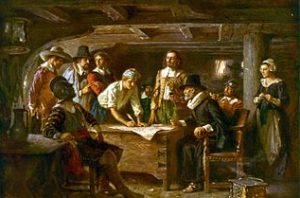 The September 6, 1620 trip to the new world, in which 102 passengers, who had been dubbed Pilgrims by William Bradford, one of the passengers who would become the first governor of Plymouth Colony, was a crowded, grueling trip on the Mayflower to a new life in the New World. The trip was filled with hardship, and sometimes even loss. Nevertheless, the pilgrims knew it had to be taken. The situation actually began in 1606, when a group of reform-minded Puritans in Nottinghamshire, England, founded their own church, that was separate from the state-sanctioned Church of England. This was truly the reason why “Freedom of Religion” is such an important part of our constitution. Many people dispute that fact that our nation was formed on religious principles, but it was, from the very core of the move here.
The September 6, 1620 trip to the new world, in which 102 passengers, who had been dubbed Pilgrims by William Bradford, one of the passengers who would become the first governor of Plymouth Colony, was a crowded, grueling trip on the Mayflower to a new life in the New World. The trip was filled with hardship, and sometimes even loss. Nevertheless, the pilgrims knew it had to be taken. The situation actually began in 1606, when a group of reform-minded Puritans in Nottinghamshire, England, founded their own church, that was separate from the state-sanctioned Church of England. This was truly the reason why “Freedom of Religion” is such an important part of our constitution. Many people dispute that fact that our nation was formed on religious principles, but it was, from the very core of the move here.
On November 11, 1620, the Mayflower anchored at what is now Provincetown Harbor, Cape Cod. Of course, it was mandatory that they scout out the new land to make sure it 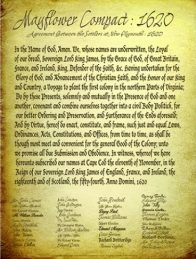 was safe before bringing the women and children there. Before going ashore, 41 male passengers…heads of families, single men and three male servants…signed the famous Mayflower Compact, agreeing to submit to a government chosen by common consent and to obey all laws made for the good of the colony. Over the next month, several small scouting groups were sent ashore to collect firewood and scout out a good place to build a settlement.
was safe before bringing the women and children there. Before going ashore, 41 male passengers…heads of families, single men and three male servants…signed the famous Mayflower Compact, agreeing to submit to a government chosen by common consent and to obey all laws made for the good of the colony. Over the next month, several small scouting groups were sent ashore to collect firewood and scout out a good place to build a settlement.
Around December 10, one of these groups found a harbor they liked on the western side of Cape Cod Bay. They returned to the Mayflower to tell the other passengers, but bad weather prevented them from docking until December 18. After exploring the region, the settlers chose a cleared area previously occupied by members of a local Native American tribe, the Wampanoag. The travel weary pilgrims finally prepared to begin their new settlement, Plymouth Colony. The Wampanoag tribe had abandoned the village several years earlier, after an outbreak of European disease. That winter of 1620-1621 was brutal, as the Pilgrims struggled to build their settlement, find food and ward off sickness. They were less than highly successful, because by spring, 50 of the original 102 Mayflower passengers were dead. The remaining settlers made contact with returning  members of the Wampanoag tribe, and in March they signed a peace treaty with a tribal chief, Massasoit. Aided by the Wampanoag, especially the English-speaking Squanto, the Pilgrims were able to plant crops…especially corn and beans…that were vital to their survival. The Mayflower and its crew left Plymouth to return to England on April 5, 1621.
members of the Wampanoag tribe, and in March they signed a peace treaty with a tribal chief, Massasoit. Aided by the Wampanoag, especially the English-speaking Squanto, the Pilgrims were able to plant crops…especially corn and beans…that were vital to their survival. The Mayflower and its crew left Plymouth to return to England on April 5, 1621.
Over the next several decades, more and more settlers made the trip across the Atlantic to Plymouth, which gradually grew into a prosperous shipbuilding and fishing center. In 1691, Plymouth was incorporated into the new Massachusetts Bay Association, ending its history as an independent colony. And the rest, as they say, is history.
 While most of the economy in Southeast Texas depended on agriculture, cattle ranching, and the lumber business in the 19th century, things were about to change. The presence of oil was known, but untapped until 1901 when the oil industry would change the landscape of the region. Uses for oil date back many years. In the 1500s, the Spanish used oil from seeps near Sabine Pass for caulking their ships, and to the north, settlers near Nacogdoches used seeping oil for lubricants before 1800. There were numerous discoveries in east and central Texas in the later 1800s, especially at Corsicana in 1896. Attempts were made to drill wells at Spindletop 1893 and 1896 and at Sour Lake in 1896, but they had no successful oil production along the Gulf Coast until the Lucas Gusher came in on Spindletop Hill on January 10, 1901.
While most of the economy in Southeast Texas depended on agriculture, cattle ranching, and the lumber business in the 19th century, things were about to change. The presence of oil was known, but untapped until 1901 when the oil industry would change the landscape of the region. Uses for oil date back many years. In the 1500s, the Spanish used oil from seeps near Sabine Pass for caulking their ships, and to the north, settlers near Nacogdoches used seeping oil for lubricants before 1800. There were numerous discoveries in east and central Texas in the later 1800s, especially at Corsicana in 1896. Attempts were made to drill wells at Spindletop 1893 and 1896 and at Sour Lake in 1896, but they had no successful oil production along the Gulf Coast until the Lucas Gusher came in on Spindletop Hill on January 10, 1901.
Spindletop Hill was a salt dome oil field, that was located in the southern portion of Beaumont, Texas. People had long suspected that oil might be under the hill as the area had been known for its sulfur springs and  bubbling gas seepages that would ignite if lit. Then in August, 1892, several men including George W. O’Brien, George W. Carroll, and Pattillo Higgins formed the Gladys City Oil, Gas, and Manufacturing Company to do exploratory drilling on Spindletop Hill.
bubbling gas seepages that would ignite if lit. Then in August, 1892, several men including George W. O’Brien, George W. Carroll, and Pattillo Higgins formed the Gladys City Oil, Gas, and Manufacturing Company to do exploratory drilling on Spindletop Hill.
By September 1901, there were at least six successful wells on Gladys City Company lands. Wild speculation drove land prices around Spindletop to incredible heights. One man who had been trying to sell his tract there for $150 for three years sold his land for $20,000; the buyer promptly sold to another investor within fifteen minutes for $50,000. One well, representing an initial investment of under $10,000, was sold for $1,250,000. Legal entanglements and multimillion-dollar deals became almost commonplace. An estimated $235 million had been invested in oil that year in Texas; while some had made fortunes, others lost everything.
Following the success of the oil industry at Spindletop Hill, many people, including my grandparents, Allen and 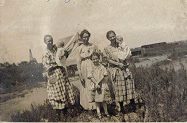 Anna Spencer would make their way to Texas in search of a better life. They would settle on the oilfields near Ranger, Texas. They didn’t find any oil fields, so their income came from his work for other people in the oilfields. These days people working in the oilfield business make good money, but as near as I can tell oilfield workers averaged about 90 cents an hour in 1919, which would be about $11.74 an hour today. That’s pretty poor wages, especially for the oilfield, but I suppose people didn’t realize how valuable they really were. Needless to say, the oilfield was not the place my grandfather would choose to make his living, and eventually they returned to Wisconsin where he went to work for the railroad.
Anna Spencer would make their way to Texas in search of a better life. They would settle on the oilfields near Ranger, Texas. They didn’t find any oil fields, so their income came from his work for other people in the oilfields. These days people working in the oilfield business make good money, but as near as I can tell oilfield workers averaged about 90 cents an hour in 1919, which would be about $11.74 an hour today. That’s pretty poor wages, especially for the oilfield, but I suppose people didn’t realize how valuable they really were. Needless to say, the oilfield was not the place my grandfather would choose to make his living, and eventually they returned to Wisconsin where he went to work for the railroad.
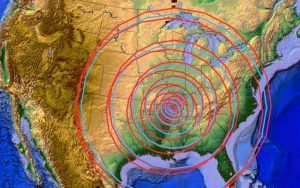 After an earthquake, especially a big quake, you start looking for damage or reports of damage. You will invariably find damage, unless the quake occurred in an area that is completely unsettled or in the ocean. Still, you have to look well beyond the epicenter of the quake…sometimes as far away as 6,000 miles. A big quake can shake things up for many miles. On December 16, 1811 a series of Intraplate earthquakes began, that shook apart the area of the New Madrid fault in present day Missouri, around the Mississippi River. Intraplate earthquakes are often confused with Interplate earthquakes, but are fundamentally different in origin, occurring within a single plate rather than between two tectonic plates on a plate boundary, like the Interplate earthquake does. The specifics of the mechanics by which they occur, as well as the intensity of the stress drop which occurs after the earthquake also differentiate the two types of events. Intraplate earthquakes have, on average, a higher stress drop than that of an Interplate earthquake and generally higher intensity,meaning they can bring more damage. These Intraplate earthquakes continued until February 7, 1812. The first earthquake on December 16th had its epicenter in northeast Arkansas and measured up to an 8 on the Mercalli intensity scale. This earthquake was followed by another six hours later, and two more on January 23rd and February 7th, respectively. The third quake caused warping, magma eruptions, fissuring and landslides. While these were unusual events for the area, the were far from the most unusual events related to this series of quakes.
After an earthquake, especially a big quake, you start looking for damage or reports of damage. You will invariably find damage, unless the quake occurred in an area that is completely unsettled or in the ocean. Still, you have to look well beyond the epicenter of the quake…sometimes as far away as 6,000 miles. A big quake can shake things up for many miles. On December 16, 1811 a series of Intraplate earthquakes began, that shook apart the area of the New Madrid fault in present day Missouri, around the Mississippi River. Intraplate earthquakes are often confused with Interplate earthquakes, but are fundamentally different in origin, occurring within a single plate rather than between two tectonic plates on a plate boundary, like the Interplate earthquake does. The specifics of the mechanics by which they occur, as well as the intensity of the stress drop which occurs after the earthquake also differentiate the two types of events. Intraplate earthquakes have, on average, a higher stress drop than that of an Interplate earthquake and generally higher intensity,meaning they can bring more damage. These Intraplate earthquakes continued until February 7, 1812. The first earthquake on December 16th had its epicenter in northeast Arkansas and measured up to an 8 on the Mercalli intensity scale. This earthquake was followed by another six hours later, and two more on January 23rd and February 7th, respectively. The third quake caused warping, magma eruptions, fissuring and landslides. While these were unusual events for the area, the were far from the most unusual events related to this series of quakes.
After the February earthquake, it was reported that the Mississippi River began running backwards, and event that lasted for several hours and caused two temporary waterfalls to develop. The upthrusting of land caused the formation of Reelfoot Lake 15 miles south of the epicenter while the crushing of quartz crystals underground created flashing lights that lit up the sky. Boatmen on flatboats actually survived this experience and lived to tell the tale. Incredibly, the earthquakes could be felt over 50,000 square miles. That is shocking when you think about the fact that the 1906 San Francisco earthquake, which was deadly enough in its own right, was felt over 6,000 square miles.
The New Madrid earthquakes were the biggest earthquakes in American history. While they occurred in the  central Mississippi Valley, they were felt as far away as New York City, Boston, Montreal, and Washington D.C. President James Madison and his wife Dolly even felt them in the White House, and church bells rang in Boston. From December 16, 1811 through March of 1812 there were over 2,000 smaller earthquakes in the central Midwest, and between 6,000-10,000 earthquakes in the Bootheel of Missouri where New Madrid is located near the junction of the Ohio and Mississippi Rivers. In the known history of the world, no other earthquakes have lasted so long or produced so much evidence of damage as the New Madrid earthquakes. Three of the earthquakes are on the list of America’s top earthquakes: the first one on December 16, 1811, a magnitude of 8.1 on the Richter scale; the second on January 23, 1812, at 7.8; and the third on February 7, 1812, at as much as 8.8 magnitude.
central Mississippi Valley, they were felt as far away as New York City, Boston, Montreal, and Washington D.C. President James Madison and his wife Dolly even felt them in the White House, and church bells rang in Boston. From December 16, 1811 through March of 1812 there were over 2,000 smaller earthquakes in the central Midwest, and between 6,000-10,000 earthquakes in the Bootheel of Missouri where New Madrid is located near the junction of the Ohio and Mississippi Rivers. In the known history of the world, no other earthquakes have lasted so long or produced so much evidence of damage as the New Madrid earthquakes. Three of the earthquakes are on the list of America’s top earthquakes: the first one on December 16, 1811, a magnitude of 8.1 on the Richter scale; the second on January 23, 1812, at 7.8; and the third on February 7, 1812, at as much as 8.8 magnitude.
In addition to the Mississippi River running backwards, there were numerous other strange happenings too. As the area experienced more than 2,000 earthquakes in five months, people learned that most of the crevices opening up during an earthquake ran from north to south, so when the earth began moving, they would chop down trees in an east-west direction and hold on using the tree as a bridge. Unfortunately, there were also “missing people” who were most likely swallowed up by the earth. Some earthquake fissures were as long as five miles. Another strange event, though not totally unusual was the sand boils that formed. A sand boil is sand and water that come out onto the ground surface during an earthquake as a result of liquefaction at shallow depth. The world’s largest sand boil was created by the New Madrid earthquake. It is 1.4 miles long and 136 acres in extent, located in the Bootheel of Missouri, about eight miles west of Hayti, Missouri. Locals call it “The Beach.” Other, much smaller, sand boils were also found throughout the area. Small pellets up to golf ball sized tar balls were found in sand boils and fissures. Known as Seismic Tar Balls, they are petroleum that has been solidified, or “petroliferous nodules.” Lights flashed from the ground, caused by quartz crystals being squeezed. Generally known as Earthquake Lights, the phenomena is scientifically called “seismoluminescence.”
Water thrown up by an earthquake was lukewarm. It is speculated that the shaking caused the water to heat up and/or quartz light heated the water. The skies turned dark during the earthquakes, so dark that lighted lamps didn’t help. The air smelled bad, and it was hard to breathe. It is speculated that it was smog containing 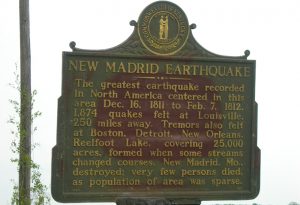 dust particles caused by the eruption of warm water into cold air. Sounds of distant thunder and loud explosions accompanied the earthquakes. People reported strange behavior by animals before the earthquakes. They were nervous and excited. Domestic animals became wild, and wild animals became tame. Snakes came out of the ground from hibernation. Flocks of ducks and geese landed near people. I’m sure that some of these events could be viewed as normal during n earthquake, but certainly some of them or even the mere numbers of these phenomena could be viewed as very strange, and I don’t know that there has ever been a more strange earthquake before or since.
dust particles caused by the eruption of warm water into cold air. Sounds of distant thunder and loud explosions accompanied the earthquakes. People reported strange behavior by animals before the earthquakes. They were nervous and excited. Domestic animals became wild, and wild animals became tame. Snakes came out of the ground from hibernation. Flocks of ducks and geese landed near people. I’m sure that some of these events could be viewed as normal during n earthquake, but certainly some of them or even the mere numbers of these phenomena could be viewed as very strange, and I don’t know that there has ever been a more strange earthquake before or since.
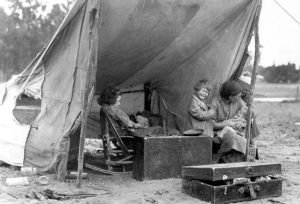
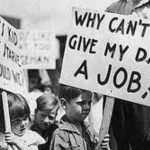 Following the Crash of 1929, which occurred on October 29, 1929, people quickly found that the jobs they thought were secure, were not only not secure, they were gone. That day became known as Black Tuesday. It was the day the stock market took a huge hit, as investors traded some 16 million shares on the New York Stock Exchange in a single day. Billions of dollars were lost, wiping out thousands of investors. The Great Depression followed the crash of 1929…banks failed, businesses closed, city streets were desolate, families lost their homes, and unemployment in rose to nearly 25%. The crash was the culmination of many years of economic instability. In the middle part of the United States, the depression occurred during the drought season. The farmers quickly lost their lands, because their crops died out, and many became migrant workers. They traveled around the country, hoping to find work for all members of the family in exchange for a meal or a place to sleep. Husbands and fathers traveled great distances from their homes in search of any work that they could find. There was no work…anywhere. Times were just about the worst they could possibly be.
Following the Crash of 1929, which occurred on October 29, 1929, people quickly found that the jobs they thought were secure, were not only not secure, they were gone. That day became known as Black Tuesday. It was the day the stock market took a huge hit, as investors traded some 16 million shares on the New York Stock Exchange in a single day. Billions of dollars were lost, wiping out thousands of investors. The Great Depression followed the crash of 1929…banks failed, businesses closed, city streets were desolate, families lost their homes, and unemployment in rose to nearly 25%. The crash was the culmination of many years of economic instability. In the middle part of the United States, the depression occurred during the drought season. The farmers quickly lost their lands, because their crops died out, and many became migrant workers. They traveled around the country, hoping to find work for all members of the family in exchange for a meal or a place to sleep. Husbands and fathers traveled great distances from their homes in search of any work that they could find. There was no work…anywhere. Times were just about the worst they could possibly be.
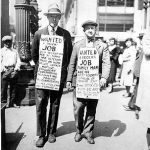
Architects, bankers, engineers and educators suddenly found themselves standing in long unemployment lines, competing for menial, basic jobs with pay that was barely enough to put food on their tables. Men who had defined themselves by taking care of their families, being the breadwinner, struggled with the emotional depression that came with the economic depression. As men traveled farther and farther away from home looking for jobs, they are forced to find lodging in public housing or shelters, waking up to begin job hunting again the next morning. Husbands and fathers who had previously earned enough money to feed and clothe their families were forced to stand in bread lines to receive free food so their families would not starve.
People became so desperate for work. As men went from town to town, they were met with billboard signs telling them to keep going, because there was no work in the town. Men with families even got their children involved, carrying signs asking why no one would hire their dad. Then men started wearing their resume on cardboard placards that they wore as they walked along. It seemed incredulous to the men who had been in higher paid jobs, that they could no longer find work…even with their qualifications. Signs like one saying, “I know 3 trades, I speak 3 languages, fought for 3 years, have 3 children and no work for 3 months. But I only 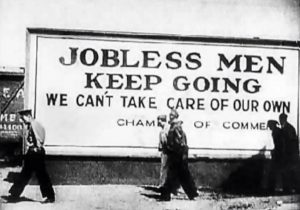
 want one job,” appeared everywhere. Times couldn’t possibly get worse. While there’s no consensus about the exact end of the Great Depression among economic historians, the unemployment rate remained high for the rest of the 1930s, even as the banking crisis eased up. One major event, however, shifted the focus of the country away from the Great Depression. After the Japanese attack on Pearl Harbor on December 7, 1941, millions of men and women would join the work force as the US entered World War II.
want one job,” appeared everywhere. Times couldn’t possibly get worse. While there’s no consensus about the exact end of the Great Depression among economic historians, the unemployment rate remained high for the rest of the 1930s, even as the banking crisis eased up. One major event, however, shifted the focus of the country away from the Great Depression. After the Japanese attack on Pearl Harbor on December 7, 1941, millions of men and women would join the work force as the US entered World War II.
 My great grand niece, Reece Victoria Renae Balcerzak is a little girl who has coma a long way is just one year. Looking back on her first year of life can take her family from the deepest fear of loss to the greatest thrill of victory. Reece was originally due February 17, 2018, but on December 1, 2017, things went wrong in a scary way. While Reece’s parents, Katie and Keifer, were sitting on the couch talking about the future and the precious little life Katie was carrying, her water broke. They rushed to the hospital, where the staff prepared them for a ride in an ambulance to the airport, and a trip on Life Flight to Denver where they were taken to Presbyterian Saint Luke’s Hospital. They had such different plans for this time in their lives.
My great grand niece, Reece Victoria Renae Balcerzak is a little girl who has coma a long way is just one year. Looking back on her first year of life can take her family from the deepest fear of loss to the greatest thrill of victory. Reece was originally due February 17, 2018, but on December 1, 2017, things went wrong in a scary way. While Reece’s parents, Katie and Keifer, were sitting on the couch talking about the future and the precious little life Katie was carrying, her water broke. They rushed to the hospital, where the staff prepared them for a ride in an ambulance to the airport, and a trip on Life Flight to Denver where they were taken to Presbyterian Saint Luke’s Hospital. They had such different plans for this time in their lives.
On October 5, 2017, Katie and Keifer found out that their bundle of joy was going to be a girl. They couldn’t have been more excited, and now on December 1, 2017, they couldn’t have been more scared. After all, Katie was just 28 weeks pregnant. Birth now was just too soon. Keifer later wrote, “Presbyterian Saint Luke’s Hospital has been an  amazing place. The Doctors and Nurses are top notch and treat us like normal human beings. We have been told that they hope to keep Katie pregnant for another 5 weeks before she will be induced. However, it’s very scary because with her water being broken we all know she could begin labor at any given time. After Katie gives birth our baby girl will be here until her original birth day of February 17, 2018.” The goal of five more weeks was not to be, and on December 14, 2018, Reece made her
amazing place. The Doctors and Nurses are top notch and treat us like normal human beings. We have been told that they hope to keep Katie pregnant for another 5 weeks before she will be induced. However, it’s very scary because with her water being broken we all know she could begin labor at any given time. After Katie gives birth our baby girl will be here until her original birth day of February 17, 2018.” The goal of five more weeks was not to be, and on December 14, 2018, Reece made her  entrance into the world. She was born at 2:23pm, weighing just 3 pounds 11 ounces. She was just 17¾ inches long.
entrance into the world. She was born at 2:23pm, weighing just 3 pounds 11 ounces. She was just 17¾ inches long.
That unplanned arrival marked the traumatic start to little Reece’s life, but her story did not end there. Reece received amazing care at Presbyterian Saint Luke’s Hospital. The are like God’s miracle working network for babies, preemie or just sick. A very long 60 days later, Katie and Keifer left Presbyterian Saint Luke’s Hospital, with very mixed emotions. They wanted to go home, but as any parent of a preemie will tell you, that carries with it the worry over your child. Nevertheless, before long, Reece’s sweet smiles and her darling personality soothed their worried minds, because it was obvious that their little girl was going to be just fine at home too. Reece has made amazing progress, and while she may still be a bit smaller than average, she is a happy, healthy one year old. Today is Reece’s 1st birthday. Happy birthday Reece!! Have a great day sweet girl!! We love you!!

